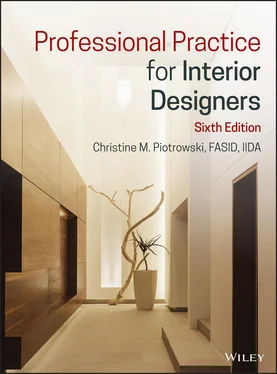Christine M. Piotrowski - Professional Practice for Interior Designers
Здесь есть возможность читать онлайн «Christine M. Piotrowski - Professional Practice for Interior Designers» — ознакомительный отрывок электронной книги совершенно бесплатно, а после прочтения отрывка купить полную версию. В некоторых случаях можно слушать аудио, скачать через торрент в формате fb2 и присутствует краткое содержание. Жанр: unrecognised, на английском языке. Описание произведения, (предисловие) а так же отзывы посетителей доступны на портале библиотеки ЛибКат.
- Название:Professional Practice for Interior Designers
- Автор:
- Жанр:
- Год:неизвестен
- ISBN:нет данных
- Рейтинг книги:4 / 5. Голосов: 1
-
Избранное:Добавить в избранное
- Отзывы:
-
Ваша оценка:
- 80
- 1
- 2
- 3
- 4
- 5
Professional Practice for Interior Designers: краткое содержание, описание и аннотация
Предлагаем к чтению аннотацию, описание, краткое содержание или предисловие (зависит от того, что написал сам автор книги «Professional Practice for Interior Designers»). Если вы не нашли необходимую информацию о книге — напишите в комментариях, мы постараемся отыскать её.
Professional Practice for Interior Designers
Professional Practice for Interior Designers — читать онлайн ознакомительный отрывок
Ниже представлен текст книги, разбитый по страницам. Система сохранения места последней прочитанной страницы, позволяет с удобством читать онлайн бесплатно книгу «Professional Practice for Interior Designers», без необходимости каждый раз заново искать на чём Вы остановились. Поставьте закладку, и сможете в любой момент перейти на страницу, на которой закончили чтение.
Интервал:
Закладка:
There have been lots of arguments as to whether interior designers should be generalists or specialists. It is believed that when the economy is slow or flat, a generalist can find projects of some kind while a specialist might find himself twiddling his thumbs. Both arguments have merit.
The generalist feels that she is able to design any kind of space, whether it is a residence or a commercial facility of some kind. However, clients have increasingly indicated that they like to hire experts. A client who hires someone to design a private residence wants that designer to understand the needs of residential design. A client who hires someone to design a store or medical office wants to know that the interior designer is familiar with that client's business and design needs. This brief section discusses decisions the designer must make if she wishes to specialize rather than be a generalist.
Many specialty areas require extensive job experience and even additional education. For example, a designer does not become successful at the design of healthcare spaces without experience and knowledge about healthcare practice. But how can one find out what experience or education is required for any specific career option in interior design?
A very practical way to prepare for career specialization is to interview designers who already work in that segment of the design field. Interior designers are like most people: They love to talk about what they do and are flattered to find out that others are interested in their work. It is suggested that the individual ask for no more than 30 minutes of the designer's time; this shows respect for his or her professional responsibilities.
Researching the specialty is one way of understanding that specialty. Reading textbooks, design books, and trade publications on the specialty is one easy way to learn about it. Interior design and architecture trade magazines provide impressions of what it is like to design all types of interiors.
Personal experience can be another way to learn about a specialty. Some students become interested in healthcare design because of a family member's health problems. Those who work their way through college with jobs in retail stores often become interested in visual merchandising or retail design. Family members and family friends certainly influence a career direction and may also influence a specialty focus. For example, perhaps an uncle is a veterinarian who talks about the importance of the interior for keeping animals calm during office visits.
It is advisable to seek additional coursework that will indirectly provide general background information about a design specialization. For example, someone who wishes to specialize in hospitality design should take some introductory classes in the hospitality industry. Those who wish to work in retail design would be wise to take merchandising and visual merchandising classes.
Students should also recognize that many specialized interior design firms might not hire an entry‐level designer. I have heard from numerous specialized firm principals over the years that they simply do not hire entry‐level designers. In general, the reason is that the lack of actual work experience prevents an entry‐level designer from working at the pace and intensity needed in such firms. “We need designers who can hit the ground running,” commented one such principal. “Entry‐level designers, regardless of the quality of their talent, cannot do this,” the principal continued. Their advice is for students to get good‐quality actual work experience and learn what it is really like to work in design before they apply for a job in a highly specialized design firm. Of course, there is no reason a newly graduated student could not apply anyway. Being in the right place at the right time has gotten many designers their first job.
Residential Interior Design
Residential interior design deals with private living spaces, most frequently the freestanding, single‐family home, as well as many other types of private residences. Designers might also specialize in functional areas within the umbrella of a residence, such as kitchen and bath design. Other specialty areas are listed in Table 5‐3.
An important characteristic of residential interior design is the personal relationship that usually develops between the client and the designer. The ability to get along with people and develop sensitivity in questioning clients, to uncover their needs and wants, is very important. Residential clients are quite particular about what they buy and how their home reflects their image. Tact and diplomacy are a must, when showing the client the realities of good and bad design ideas and translating expressed desires into a design concept with which the client can live.
Commercial Interior Design
Commercial interior design—sometimes called contract interior design —involves the design and specification of public spaces, such as offices, hotels, hospitals, restaurants, and so on. It is normal for a commercial designer to focus his or her practice on only one area or perhaps on a few types of related public spaces. Depending on the size of the design firm, a firm might offer expertise in multiple specialties. Table 5‐4is a partial list of the specialties that exist within commercial interior design.
An important skill for the commercial interior designer is to have knowledge and appreciation of the client's business. This knowledge helps the designer ask better questions about the needs and goals of the client during programming. The designer also realizes that clients are different even when they are in similar business categories. Therefore, the designer needs to understand the business of the business in order to make appropriate design decisions.
TABLE 5‐3. Partial list of residential interior design specialties
| Single‐family homes | Model homes and apartments |
| Townhouses | Dormitories |
| Condominiums | Sustainable design |
| Patio homes | Senior housing |
| Apartments | Apartments in assisted‐living facilities |
| Manufactured housing units | Color consultation |
| Vacation homes | Historical restoration/renovation |
| Residential restoration | Custom closets/storage |
| Kitchen and/or bathroom design | Residential children's spaces |
| Home offices | Renovation for the physically challenged |
| Home theater design | Private yachts and houseboats |
| Music rooms/game rooms | Home staging |
TABLE 5‐4. Partial list of commercial interior design specialties
| Almost any kind of commercial or business facility can become a specialty in interior design. Choosing too narrow a specialty, however, can limit the amount of business the interior designer will be able to obtain. |
| General offices |
| Facility planning |
| Corporate executive offices |
| LEED ® specialist |
| Professional offices |
| Law |
| Advertising/public relations |
| Accounting |
| Stockbrokers and investment brokers |
| Real estate and real estate development |
| Financial institutions: banks, credit unions, and trading centers |
| Architecture, engineering, and interior design |
| Consultants of various kinds |
| Health care |
| Hospitals and health maintenance group facilities |
| Medical specialty office suites |
| Nursing homes and assisted‐living facilities |
| Medical and dental office suites |
| Outpatient laboratories and radiological treatment facilities |
| Psychiatric facilities |
| Rehabilitation facilities |
| Medical laboratories |
| Veterinary clinics |
| Hospitality and recreation |
| Hotel, motels, and resorts |
| Restaurants, coffee shops, etc. |
| Commercial kitchens |
| Recreational facilities |
| Health clubs and spas |
| Country clubs |
| National and state park facilities |
| Amusement park facilities |
| Sports complexes |
| Auditoriums and theaters |
| Museums |
| Convention centers |
| Casinos |
| Set design: movies and television |
| Retail facilities/merchandising |
| Malls and shopping centers |
| Department stores |
| Specialized retail stores |
| Gift shops in hotels, airports, and other facilities |
| Store visual merchandising |
| Displays for trade shows |
| Showrooms |
| Galleries |
| Boutiques |
| Educational and institutional facilities |
| Colleges, universities, and community colleges |
| Secondary and elementary schools |
| Day‐care centers and nursery schools |
| Private schools |
| Churches and other religious facilities |
| Government offices (federal, state, and local) |
| Courthouses and courtrooms |
| Prisons |
| Industrial facilities |
| Corporate offices |
| Manufacturing facilities |
| Training facilities |
| Employee service areas, such as lunchrooms and fitness centers |
| Transportation |
| Airports, bus terminals, train depots, etc. |
| Tour ship design |
| Custom and commercial airplane interiors |
| Boats and ships |
| Recreational vehicles |
| Adaptive use |
| Restoration of historic commercial sites |
| Commercial products design |
It is also important to realize that the client who has contracted with the designer is often only one of the users/stakeholders that must be satisfied. The satisfaction of employees and the public or the clientele of the business directly affects the success of the design and future business. Not understanding and designing in relationship to this issue can result in a nice‐looking interior for an unhappy client.
Читать дальшеИнтервал:
Закладка:
Похожие книги на «Professional Practice for Interior Designers»
Представляем Вашему вниманию похожие книги на «Professional Practice for Interior Designers» списком для выбора. Мы отобрали схожую по названию и смыслу литературу в надежде предоставить читателям больше вариантов отыскать новые, интересные, ещё непрочитанные произведения.
Обсуждение, отзывы о книге «Professional Practice for Interior Designers» и просто собственные мнения читателей. Оставьте ваши комментарии, напишите, что Вы думаете о произведении, его смысле или главных героях. Укажите что конкретно понравилось, а что нет, и почему Вы так считаете.












